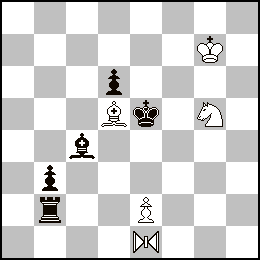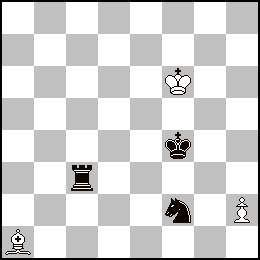A Pervakov to follow, so it's good stuff
3 - White to play and win

W.: Kh1, Bb4 and e8, pa7, b2, d2 and h6
B.: Ke1, Ra6, Bb1, pa5, b3, c7 and g4
To be enjoyed without moderation on the theme of Philidior
The last study is a pawn endgame
4 - white to play and draw

W.: Kf7, pa4, c4 and c6
B.: Kb6, pc5 and h7
With the help of Reti, you should find it easily enough, but beware that there are some threads.
The day's game and the end of the following one have a nice point in common noted by the Master
5 - game of the day
1. d4 d5 2. c4 e6 3. Nc3 Nf6 4. Bg5 Nbd7 5. e3 c6 6. Nf3 Be7 7. Qc2 0-0 8. a3 (8. 0-0-0 is more in the modern concepts of play) Re8 9. Rc1 dc 10. Bxc4 Nd5 11. Bxe7 Qxe7 12. Ne4 (to avoid exchanges of pieces and in particular the cavalry) N5f6 13. Ng3 c5 (13. ... e5 14. Nf5) 14. 0-0 cd 15. Nxd4 Nb6 16. Ba2 (16. Bb5 Bd7 17. Qc7 Bxb5 18. Qxe7 Rxe7 19. Nxb5 Nd5 and it holds for Black) Rb8 (a prophylactic move with a tactical profile) 17. e4 Rd8 18. Rfd1 Bd7 19. e5 (19. Qc7 Rdc8 20. Qe5 Ne8! and all is well) Ne8! (19. ... Nd5 20 BxN NxB 21. Ndf5! Qg5 22. h4 Qf4 23. Nxg7 Ne3 24. Qd2 Nxg2 25. Nh5 with a good white figural game) 20. Bb1 g6 21. Qe4 Ba4 ! 22. b3 Bd7! 23. a4 (as a result of the manoeuvre the square b4 is available to the black knight) Nd5 24. Bd3 (24. h4 right away is worth exploring) Rbc8 25. Bc4 26. Nxc6 bc (it would be from Petrosian) 27. Rd3 (27. Bxd5 leads to a draw i.e. we move the Queen and bring the Knight on d4) Nb4 28. Rf3 Rc7 29. h4 Rcd7 30. h5 Qg5 31. Re1 Rd4 32. hg hg (32. ... Rxe4 33. gf+ Kf8 34. Nxe4 and fxe8=Q+ are sufficient to win) 33. Qe2 Rd2 34. Qf1 (threatens Ne4) Nc2 ! (even so) 35. Ne4 Qxe5 36. Nf6+ Qxf6 37. Rxf6 Nxf6 38. Rc1 (38. Re2) Ne4 39. Be2 Nd4 40. Bf3 Nxf2 41. Qc4 Nd3 42. Rf1 Ne5 43. Qb4 Nexf3+ 44. gf Ne2+ 45. Kh2 Nf4+ 46. Kh1 R2d4 27. Qc7 Kg7 48. Qc7 R8d5 49. Re1 Rg5 50. Qxc6 Rd8! resigns
6 - of the same after the 14th white move
position
W.: Kg1, Qc2, Ra1 and f1, Bd3, Ne3 and f3, pa2, b2, d4, f2, f4, g3 and h2
B.: Kg8, Qd8, Ra8 and e8, Bc8 and d6, Nf8, pa7, b7, c6, d5, f6, g7 and h7
14. ... Be6 15. Nh4 Bc7 (to put pressure on d4) 16. b4 Bb6 17. Nf3 Bf7 18. b5 (18. Rfd1) Bh5 19. g4 Bf7 (same way as in the previous game with same effects) 20. bc Rc8 21. Qb2 bc 22. f5 Qd6 23. Ng2 Bc7 24. Rfe1 h5 25. h3 Nh7 26. Rxe8 Rxe8 27. Re1 28. Qc1 Ng5 29. Ne5 fe 30. Qxg5 e4 31. f6 g6 32. f4 hg (32. ... ef e.p. 33. Re5) 33. Be2 gh 34. Bh5 Rb2 35. Nh4 Qxf4 resigns
a nice little helpmate to get the hang of it
7 - h#2 with Equihopper and Grasshopper
helpmate : Black to play and help White to checkmate them
Equihopper : piece that uses the support of another piece to move by an equipollent movement with respect to the sautoir
Grasshopper : piece with march of the Queen who needs a sautoir to move and lands just behind the sautoir if the square is free or occupied by an opponent's piece

W.: Kg7, Bd5, Ng5, pe2 Ee1
B.: Ke5, Rb2, Bc4, pb3 and d6
a) statement position
b) Ee1 becomes Ge1
A little Circe of a special kind to finish
8 - h#3,5 Clone Circe
helpmate 3,5 moves : white plays first and then we find ourselves in a 3 move helpmate
Clone Circe : a captured piece changes its nature and adopts that of the capturing piece and is reborn on the original square of its new nature

W.: Kf6, Ba1, ph2
B.: Kf4, Rc3, Nf2
That's it, it's time to wrap up, so it remains to wish you a good reading and see you soon for the corrections made by the Master.
Yours sincerely
Le greffier
Comments
1 Alain On Tuesday, july 12, 2022